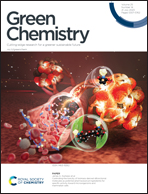Benzylic C–H arylation with dicyanoarenes via convergent paired electrolysis†
Abstract
We describe the convergent paired electrolysis of methylarene derivatives and 1,4-dicyanoarenes to perform the arylative functionalization of a benzylic C(sp3)–H bond to form 1,1-biarylmethane derivatives that are found in several drugs and biologically active compounds. This electrochemical process proceeds via the coupling of a benzylic radical or a benzylic carbocation with a 1,4-dicyanoarene radical anion to form the desired C–C bond followed by elimination of the cyanide anion which could be trapped as a cyanhydrin by an aldehyde. These reactive species are produced, respectively, by the oxidation of the benzylic substrate at the anode and the reduction of the dicyanoarene at the cathode. One of the key challenges that we have overcome is avoiding the formation of overoxidized coupling products at the bisbenzylic position of the biarylmethane products obtained.

- This article is part of the themed collection: Advances in Electrosynthesis for a Greener Chemical Industry


 Please wait while we load your content...
Please wait while we load your content...